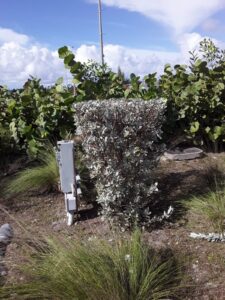How to Care for Silver Buttonwood

Hailed for its beautiful gray-silverish colored leaves and velvety texture along with its ability to withstand salt sprays the silver buttonwood is native to the coast of tropical America from Florida through the West Indies and the Caribbean.
This shrub belongs to the family Combretaceae, in its natural habitat silver buttonwood can be found growing in mangroves and on the shorelines of tropical and sub-tropical regions worldwide.
Affiliate Disclaimer
As the owner of this website, I’ve tracked down special deals for some of the products mentioned here. When you use the links on this page to make a purchase I may get a small commission and you will get a great bargain. It’s a WIN-WIN for both of us.
The sliver buttonwood has made its way into the hearts of many people and can be found in many home gardens and commercial landscape designs. This garden beauty can be trained to grow as a shrub or tree and will grace your landscape with its charm. For more on the care of sliver buttonwood let’s take a closer look.
The planting location
The silver buttonwood prefers full to partial sunlight and can grow up to 20 ft so provide them with sufficient space to grow or keep them well pruned to about 5 ft.
Soil requirements
Because the silver buttonwood is a drought-tolerant plant soil that’s well-drained such as sandy soil that’s alkaline will encourage the plant to thrive.
Water requirements
Though the silver buttonwood is drought-resistance keeping it well watered will encourage the plant to be full and lush. However, do not saturate the soil which can lead to defoliation (leaf drop).
Fertilizer requirements
Fertilizer your silver buttonwood in the spring, summer, and autumn or 3 times per year with a high granular fertilizer that is ideal and will help in maintaining your buttonwood.
Garden insect pest problems
When it comes to the silver buttonwood garden pests are low which makes this plant a winner. However, garden pests to keep a watch for are aphids and the Florida wax scale. The use of insecticides such as insecticidal soap or horticultural oil will bring pests under control. Before applying read and follow the label for the best results.
Disease issues
The only issue I have had with silver buttonwood is sooty mold, this mold appears on the leaves’ surface as black dust which can really destroy the beautiful sliver-grayish leaves.
Sooty mold is encouraged by the secretion of the named listed pests, controlling insect pests will also control and discourage sooty mold. For more on sooty mold and its control refer to controlling sooty mold.
Pruning procedures
Sliver buttonwood can be pruned to the desired shape whether boxed, circle, etc… selective pruning throughout the year will work wonders. What I also notice with silver buttonwood is that because this plant can grow so dense the leaves in the middle and at the bottom of the plant tense to turn brown flowed by leaf drop.
A good practice is not to let the center get so crowded that rubbing takes place along with sunlight being blocked from getting to the lower leaves. Selective prune by removing some of the central branches for a more open plant that will provide good air circulation and where sunlight will also get inside and to the bottom branches as well.
Hard pruning of your silver buttonwood can be carried out in the spring, late March, or early April. However, branches that are low-hanging diseased infested, or broken can be removed at any time of the year.
Growing sliver buttonwood in containers
Silver buttonwood can also be grown from containers by following what was discussed above. The container that’s chosen should be large enough for your plant to sit comfortably as it matures.
The container should also have drain holes for drainage because as mentioned silver buttonwood doesn’t like wet feet. Keep plant pruned to desired shape and height.
If buttonwood outgrows the container then transfer it to a larger container or into the ground.
Ideas where to install silver buttonwood
- Silver buttonwood can be planted in coastal areas
- Can be grown as a hedge
- Looks great along driveways
- Can be used as a backdrop in garden beds
- Can be grown as a specimen plant
- Can work as a privacy screen
- Can be used at the corners of houses and other structures
- Place them alongside a fenced area
- Will cover large areas such as a wall
The final word on silver buttonwood care
The silver buttonwood is an amazing plant that will go to work for you as long as its requirements are met. I have worked with this tropical beauty for many years and have seen what they can do. Silver buttonwood is one of my favorites that is not fussy it’s a low-maintenance plant that will bring flavor into your garden and landscape. This plant won’t disappoint but will reward you with its beauty and charm.
About the author
Norman loves being in the garden, both at home and for his job....
he is 'Natures Little helper' being outdoors, growing his vegetables and flowers from an early age.
Now having spent over 22 years in the profession he want to give some of his knowledge to others...
his vast array of hints and tips you will find scattered over this site will help you no end growing plants in your garden.
